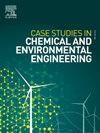A comprehensive review on life-cycle assessment of concrete using industrial by-products
Q1 Environmental Science
Case Studies in Chemical and Environmental Engineering
Pub Date : 2025-07-17
DOI:10.1016/j.cscee.2025.101260
引用次数: 0
Abstract
The present study, highlights the life cycle analysis (LCA) of concrete, from material procurement to the final disposal of the final product, after its service life was studied. Two types of concrete, M30, and M50, were employed to compare the sustainability performance with incorporating natural and recycled materials. The recycled material is sourced from the demolished building, which is processed to remove the unwanted debris and obtain quality aggregates ranging from 10 mm to 12.5 mm. The processed recycled aggregates (RA) were replaced with 50 % and 100 % of conventional natural aggregate in the concrete. The greenhouse gas emission (GHG-e) and the embodied energy (EE) of the concrete mix ingredients were analyzed with the concrete production. In comparison with the M30 and M50 grade concrete, nearly, 17 % lower GHG-e was recorded for M30 grade concrete when compared to M50 grade concrete. After the service life of concrete, the GHG-e and EE associated during the demolition, loading, and transportation of demolished material was found to be 4.62 kg-CO2/m3 and 63.67 MJ/m3.
工业副产物混凝土生命周期评价研究综述
本研究强调混凝土的生命周期分析(LCA),从材料采购到最终产品的最终处置,在其使用寿命进行了研究。两种类型的混凝土,M30和M50,被用来比较掺入天然和回收材料的可持续性性能。回收材料来自已拆除的建筑物,经过处理以去除不需要的碎片,并获得10毫米至12.5毫米的优质骨料。经过处理的再生骨料(RA)在混凝土中被50%和100%的传统天然骨料所取代。结合混凝土生产情况,分析了混凝土配合料的温室气体排放(GHG-e)和蕴含能(EE)。与M30和M50级混凝土相比,M30级混凝土的温室气体排放量比M50级混凝土低近17%。混凝土使用年限结束后,拆除、装载、运输过程中产生的温室气体排放量为4.62 kg-CO2/m3, EE为63.67 MJ/m3。
本文章由计算机程序翻译,如有差异,请以英文原文为准。
求助全文
约1分钟内获得全文
求助全文
来源期刊

Case Studies in Chemical and Environmental Engineering
Engineering-Engineering (miscellaneous)
CiteScore
9.20
自引率
0.00%
发文量
103
审稿时长
40 days
 求助内容:
求助内容: 应助结果提醒方式:
应助结果提醒方式:


